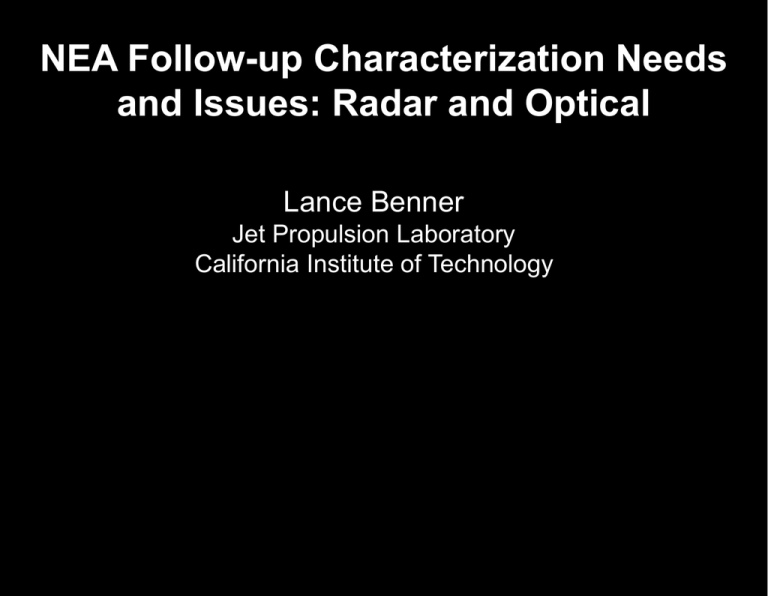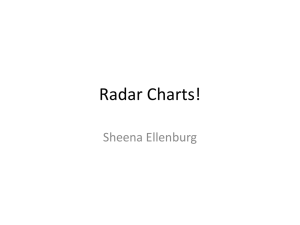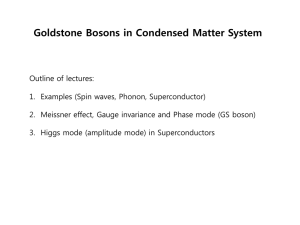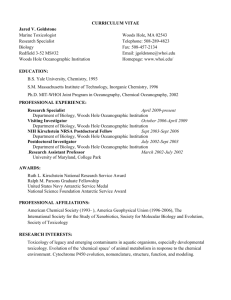Follow up Characterization Needs and Issues (RADAR
advertisement

NEA Follow-up Characterization Needs and Issues: Radar and Optical Lance Benner Jet Propulsion Laboratory California Institute of Technology What Can Radar Do? Spatially resolve objects with up to 4-meter resolution: Greatly exceeds any ground- or space-based optical telescope; 3-D shapes, convex hulls, sizes, surface features, spin states, surface roughness and density, regolith distrubutions, constrain composition; gravitational environments. Identify binary and ternary objects: orbital parameters, masses and bulk densities, orbital dynamics, constrain bulk porosity. Improve orbits: Very precise: for ARM targets, measure distances to < 10 meters. Shrink uncertainties by many ordersof-magnitude for newly-discovered NEOs. Prevent loss of objects. Predict motion for decades to centuries. Radar observations of previously-known NEOs can reduce uncertainties by several tens of percent. Goldstone 70 m Arecibo: 305 m Capabilities are complementary Arecibo Goldstone Diameter 305 m 70 m Transmitter power 900 kW 450 kW Transmitter frequency 2.38 GHz 8.56 GHz System temperature 23 K 17 K Sky coverage ~1/3 ~80% Declination coverage -1 to +38 > -35 deg Finest range resolution 7.5 m 3.75 m Arecibo is ~20x more sensitive. Goldstone sees more of the sky and can track several times longer. Arecibo is easier to schedule on short notice. Goldstone resolves slow rotators 3.6x more finely. Airspace coordination is necessary at Goldstone but not at Arecibo. Near-Earth Asteroids Observed by Radar H > 27: N =10; 2.6% of all NEAs detected by radar 2005 YU55: 2011 Nov. 9, Goldstone Rounded shape, evidence for boulders, an equatorial bulge, and craters Diameter ~ 360 meters, 1.875 m x 0.005 Hz Busch et al., in prep. Goldstone Bistatic Radar Image of 2012 XB112 Range H = 29.7, D ~ 2 m, Resolution = 3.75 m x 0.25 Hz Resolved in Doppler frequency but not in range: too small Doppler frequency Target-of-opportunity piggybacked on observations of 4179 Toutatis Radar Contributions to ARM Radar Astrometry Measure distances to < 10 meters; can prevent loss of objects Facilitate detection of perturbations from solar radiation pressure: provides area/mass ratio. ARM targets are too small for radar images; no 3D models. Echo Power Spectra: Resolve in Doppler Frequency Echo bandwidths can provide rotation period, pole direction, the convex hull, and other shape information. If area/mass ratio is known, bandwidths constrain the mass and bulk density. Convex hull places upper bounds on optical and radar albedos & constrains composition. Radar albedo gives an estimate of surface density. Circular polarization ratio gauges near-surface roughness and (in some cases) composition. Goldstone Echo from ARM Candidate 2006 RH120 Convex Hull: Silhouette from Echo Power Spectra P = 2.7 minutes E.g.: 4769 Castalia Central dip Solar radiation pressure perturbation detected & area/mass ratio estimated. Rough surface. The Smallest NEAs Observed by Radar Asteroid 2006 RH120 2007 EH 2010 AL30 2010 UM7 2011 UB 2012 BX34 2012 DH54 2012 DX 2012 XB112 2013 EC20 H 29.5 27.6 27.2 27.6 27.5 27.6 27.7 27.1 29.7 29.0 Observatory Goldstone Arecibo Goldstone Arecibo Arecibo Goldstone Arecibo Arecibo Goldstone Arecibo 2006 RH120 and 2012 XB112 are ~2 m in diameter Obstacles for Scheduling Radar Observations on Short Notice 1: Is the asteroid in the declination window? 2: Are the SNRs strong enough for a detection? 3: Are the 3s pointing uncertainties small enough (< 20 arcsec)? If not, can optical astrometry improve them sufficiently before the radar observations? 4: Can we get telescope time and observing personnel? 5: Goldstone: To transmit full power (450 kW), can we get radiation clearance in time? We can’t get it on Friday, Saturday, or Sunday and it usually takes at least two days. 6: If D < 0.008 AU, then we need to receive with a different telescope. Can we schedule DSS-13 or Green Bank? Other Issues: Radar Goldstone can observe at ¼ power without radiation clearance, enabling rapid response, but still need telescope time, observing personnel, small pointing uncertainties, and strong SNRs. Goldstone schedules fixed months in advance are difficult to change on short notice. To support ARM, priority of radar observations MUST increase. At Goldstone, we can get radiation clearance faster if we already have it for another NEA with overlapping view periods. (e.g.: 2012 XB112) For ARM targets, short notice is the biggest problem for scheduling radar observations because most targets will be close enough to detect for only a few days at best. Maintenance at Arecibo is suffering due to NSF budget cuts. The VLBA (radar speckle tracking: NEA spin states) and Green Bank (bistatic receiver for very close targets) might close due to NSF budget cuts. Goldstone currently has only one functional spare klystron. Principal Techniques for Optical Characterization Calibrated Astrometry: Improve orbits, obtain better absolute magnitudes. H values for tiny NEAs are notoriously unreliable. Lightcurves: Rotation periods and pole directions. NPA rotators and binaries. Convex shape models. Best estimates of absolute magnitudes. Small telescopes can help. Need more facilities in the southern hemisphere. Photometric Colors: Identify optically bright and dark spectral classes. Can obtain with smaller telescopes and at fainter magnitudes than vis-IR spectroscopy (e.g., 0.6 m at Table Mountain). Need more help with this. Vis-IR Spectroscopy: Spectral classes and compositions. Albedo constraints. NASA’s IRTF has a protocol for rapid responses to TOOs. Need access to more telescopes equipped for this, especially southern hemisphere. IR radiometry: Albedos and diameters using thermal emission. Also: thermal inertias. Spitzer Space Telescope, Gemini, Subaru, IRTF, et al. Not possible with small telescopes at low elevations. Optical Observations: Issues International collaboration will be critical. Need to start establish international collaborations ASAP. Optical telescopes have much less stringent pointing requirements than radar. Need sufficiently bright magnitudes and favorable solar elongations. Weather is critical. Rapid response protocols vary among observatories. Need a central clearinghouse to track observations of each ARM candidate. Need access to more facilities in the southern hemisphere. Las Cumbres Observatory Global Telescope could really help with astrometry and lightcurves. Identify mothballed or otherwise underutilized facilities to see if it would be worth returning them to service (e.g., 100” on Mt. Wilson). Siding Spring and Kitt Peak are threatened with closure and could thus be available to help. Enhancing Goldstone Radar Observations of NEAs Increase time on DSS-14 - The number of observed asteroids could be at least doubled (~50/year) - For short-notice targets-of-opportunity radiation clearance is an obstacle Upgrade the klystrons at DSS-14 - New X-band klystron design with 120 MHz bandwidth: 1.25 m resolution. - Retain current transmitter power of 450 kW - First light: 2017 (cost ~$10M) - Increase the resolution to 1.25 m AND double the power to 900 kW - SIGNIFICANTLY better science - Preliminary cost estimate: $20-30M, first light ~2020 Add an 80 MHz, 80 kW transmitter to DSS-13 (34 m antenna) - 1.875 meter resolution. 2x finer than the best currently available - DSS-13 is largely underused; usually available. - Receive at DSS-28; 1/16th as sensitive as DSS-14 - Niche system for really close flybys - Receive at Arecibo. Boosts SNR substantially 1.25 m Resolution Plus Double TX Power at DSS 14 Means: - We are in much better position to study small (and large) asteroids - Asteroids that used to be too weak for radar become detectable - Asteroids that are already observable will be stronger targets and we’ll get higher quality data - More surface features will be visible - Windows of opportunity to observe and improve the orbit will lengthen - Shape models for significantly smaller objects, including some ARM targets - Easier detection of asteroid satellites due to higher SNRs - 1.25 m resolution facilitates detection of boulders on asteroid surfaces - Enhaces bistatic tracks with Arecibo and Green Bank (5x and 2x increase in sensitivity): More opportunities to utilize 1.25 m resolution - Improves radar speckle tracking at the VLBA and VLA. More spin states. Enhancing Arecibo Radar Observations 1. Increase telescope time with additional funding. Easiest and fastest way to augment radar observations significantly. Easier to accomplish than at Goldstone. Enhanced funding will also help with overall maintenance, which is suffering again due to budget cuts from the NSF. 2. Switch Arecibo klystrons from S-band to 120 MHz klystrons at X-band. 6x finer range resolution & 3.6x finer Doppler resolution. Major changes necessary: improve X-band receivers, adjust shape of dish, probably others Cost & timeline unknown Enhancing Bistatic Radar Observations Install new X-band datataking equipment at Arecibo and Green Bank to receive 1.25 m transmissions from DSS-14 Install new equipment at DSS-14 to receive 7 GHz, 1.875 m transmissions from DSS-13 Support radar speckle experiments (PI: M. W. Busch) with the VLBA and VLA. Looming problem: The VLBA and Green Bank are facing budget cuts and may close. Closure of the VLBA would end most radar speckle tracking and that technique’s potential for obtaining significantly more NEA pole directions.







